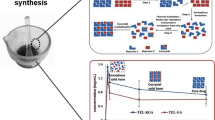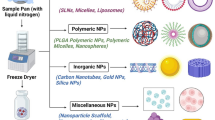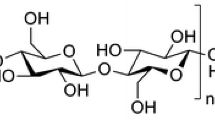Abstract
Solid-state properties of tolfenamic acid (TA) and its complexes with chitosan (CT) have been studied. Effect of medium pH, molecular weight of polymer and its different concentrations on these TA–CT complexes were studied in detail. Low and medium molecular weight CT have been used in different ratios at pH ranging from 4 to 6 and freeze-drying technique has been employed to modify the appearance of crystalline TA. Physical properties of the formed complexes have been studied by employing X-ray diffraction, differential scanning calorimetry and scanning electron microscopy; chemical structure has been studied using Fourier transform infrared spectroscopy. The results showed that both forms of the polymer exhibited complete conversion in 1:8 ratio at pH 4, 1:4 at pH 5 and 1:1 at pH 6 indicating a marked effect of pH on drug–polymer complexation. The percent crystallinity calculations indicated low molecular weight CT slightly more effective than the other form. No changes in the complexes have been observed during the 12 week storage under controlled conditions. Both forms of CT at different pH values indicated retardation of recrystallization in TA during cooling of the melt from 1:1 ratios exhibiting formation of strong intermolecular hydrogen bonding between the drug and the polymer.








Similar content being viewed by others
REFERENCES
British National Formulary 57. London: BMJ and RPS; 2009. p. 244.
Sweetman SC. Martindale: the complete drug reference. 36th ed. London: Pharmaceutical Press; 2009. Electronic version.
Liu X, Abdelrahim M, Abudayyeh A, Lei P, Safe S. The nonsteroidal anti-inflammatory drug tolfenamic acid inhibits BT474 and SKBR3 breast cancer cell and tumor growth by repressing erbB2 expression. Mol Cancer Ther. 2009;8:1207–17.
Kim JH, Jung JY, Shim JH, Kim J, Choi KH, Shin JA, et al. Apoptotic effect of tolfenamic acid in kb human oral cancer cells: possible involvement of the p38 MAPK pathway. J Clin Biochem Nutr. 2010;47:74–80.
Colon J, Basha MR, Madero-Visbal R, Konduri S, Baker CH, Herrera LJ, et al. Tolfenamic acid decreases c-Met expression through Sp proteins degradation and inhibits lung cancer cells growth and tumor formation in orthotopic mice. Investig New Drugs. 2011;29:41–51.
Eslin D, Sankpal UT, Lee C, Sutphin RM, Maliakal P, Currier E, et al. Tolfenamic acid inhibits neuroblastoma cell proliferation and induces apoptosis: A novel therapeutic agent for neuroblastoma. Mol Carcinog. 2013;52:377–86.
Shim JH, Shin JA, Jung JY, Choi KH, Choi ES, Cho NP, et al. Chemopreventive effect of tolfenamic acid on KB human cervical cancer cells and tumor xenograft by downregulating specificity protein 1. Eur J Cancer Prev. 2011;20:102–11.
Kang SU, Shin YS, Hwang HS, Baek SJ, Lee SH, Kim CH. Tolfenamic acid induces apoptosis and growth inhibition in head and neck cancer: involvement of NAG-1 expression. PLoS One. 2012;7:e34988.
Adwan LI, Basha R, Abdelrahim M, Subaiea GM, Zawia NH. Tolfenamic acid interrupts the de novo synthesis of the β-amyloid precursor protein and lowers amyloid beta via a transcriptional pathway. Curr Alzheimer Res. 2011;8:385–92.
Subaiea GM, Alansi BH, Serra DA, Alwan M, Zawia NH. The ability of tolfenamic acid to penetrate the brain: a model for testing the brain disposition of candidate Alzheimer’s drugs using multiple platforms. Curr Alzheimer Res. 2011;8:860–7.
Andrews PC, Ferrero RL, Junk PC, Kumar I, Luu Q, Nguyen K, et al. Bismuth(III) complexes derived from non-steroidal anti-inflammatory drugs and their activity against Helicobacter pylori. Dalton Trans. 2010;39:2861–8.
British Pharmacopoeia. London: Her Majesty’s Stationary Office; 2009. Electronic version.
Thybo P, Kristensen J, Hovgaard L. Characterization and physical stability of tolfenamic acid-PVP K30 solid dispersions. Pharm Dev Technol. 2007;12:43–53.
Cafaggi S, Russo E, Caviglioli G, Parodi B, Stefani R, Sillo G, et al. Poloxamer 407 as a solubilising agent for tolfenamic acid and as a base for a gel formulation. Eur J Pharm Sci. 2008;35:19–29.
Pedersen SB. Biopharmaceutical aspects of tolfenamic acid. Pharmacol Toxicol. 1994;75:22–32.
Jondhale S, Bhise S, Pore Y. Physicochemical investigations and stability studies of amorphous gliclazide. AAPS PharmSciTech. 2012;13:448–59.
Hancock BC, Zografi G. Characteristics and significance of the amorphous state in pharmaceutical systems. J Pharm Sci. 1997;86:1–12.
Trasi NS, Taylor LS. Effect of polymers on nucleation and crystal growth of amorphous acetaminophen. CrstEngComm. 2012;14:5188–97.
Ahmad I, Ahmed S, Sheraz MA, Vaid FHM. Effect of borate buffer on the photolysis of riboflavin in aqueous solution. J Photochem Photobiol B Biol. 2008;93:82–7.
Ahmad I, Ahmed S, Sheraz MA, Aminuddin M, Vaid FHM. Effect of caffeine complexation on the photolysis of riboflavin in aqueous solution: a kinetic study. Chem Pharm Bull. 2009;57:1363–70.
Ahmad I, Ahmed S, Sheraz MA, Vaid FH, Ansari IA. Effect of divalent anions on photodegradation kinetics and pathways of riboflavin in aqueous solution. Int J Pharm. 2010;390:174–82.
Rozou S, Antoniadou-Vyza E. An improved HPLC method overcoming Beer’s law deviations arising from supramolecular interactions in tolfenamic acid and cyclodextrins complexes. J Pharm Biomed Anal. 1998;18:899–905.
Rozou S, Michaleas S, Antoniadou-Vyza E. Supramolecular interactions between tolfenamic acid and various cyclodextrins: effects of complexation on physicochemical and spectroscopic data. Pharm Pharmacol Commun. 1999;5:79–84.
Vavia PR, Adhage NA. Freeze-dried inclusion complexes of tolfenamic acid with β-cyclodextrins. Pharm Dev Technol. 2000;5:571–4.
Sinha VR, Singla AK, Wadhawan S, Kaushik R, Kumria R, Bansal K, et al. Chitosan microspheres as a potential carrier for drugs. Int J Pharm. 2004;274:1–33.
Gong K, Darr JA, Rehman IU. Supercritical fluid assisted impregnation of indomethacin into chitosan thermosets for controlled release applications. Int J Pharm. 2006;315:93–8.
Rowe RC, Sheskey PJ, Quinn ME. Handbook of pharmaceutical excipients. 4th ed. London: Pharmaceutical Press; 2009. p. 159–61.
Chandy T, Sharma CP. Chitosan—as a biomaterial. Biomater Artif Cells Artif Organs. 1990;18:1–24.
Chandy T, Das GS, Rao GH. 5-Fluorouracil-loaded chitosan coated polylactic acid microspheres as biodegradable drug carriers for cerebral tumours. J Microencapsul. 2000;17:625–38.
Chandy T, Rao GH, Wilson RF, Das GS. Development of poly(lactic acid)/chitosan co-matrix microspheres: controlled release of taxol–heparin for preventing restenosis. Drug Deliv. 2001;8:77–86.
Aggarwal A, Kaur S, Tiwary AK, Gupta S. Chitosan microspheres prepared by an aqueous process: release of indomethacin. J Microencapsul. 2001;18:819–23.
Gonzalez-Rodriguez ML, Holgado MA, Sanchez-Lafuente C, Rabasco AM, Fini A. Alginate/chitosan particulate systems for sodium diclofenac release. Int J Pharm. 2002;232:225–34.
Kumbar SG, Kulkarni AR, Aminabhavi M. Crosslinked chitosan microspheres for encapsulation of diclofenac sodium: effect of crosslinking agent. J Microencapsul. 2002;19:173–80.
al-Suwayeh SA, el-Helw AR, al-Mesned AF, Bayomi MA, el-Gorashi AS. In vitro–in vivo evaluation of tableted caseinchitosan microspheres containing diltiazem hydrochloride. Boll Chim Farm. 2003;142:14–20.
Hejazi R, Amiji M. Stomach-specific anti-H. pylori therapy. II. Gastric residence studies of tetracycline-loaded chitosan microspheres in gerbils. Pharm Dev Technol. 2003;8:253–62.
Wong TW, Chan LW, Kho SB, Sia Heng PW. Design of controlled-release solid dosage forms of alginate and chitosan using microwave. J Control Release. 2002;84:99–114.
Huang Y, Yeh MK, Chiang CH. Formulation factors in preparing BTM–chitosan microspheres by spray drying method. Int J Pharm. 2002;242:239–42.
Huang YC, Yeh MK, Cheng SN, Chiang CH. The characteristics of betamethasone-loaded chitosan microparticles by spray-drying method. J Microencapsul. 2003;20:459–72.
Baird JA, Van Eerdenbrugh B, Taylor LS. A classification system to assess the crystallization tendency of organic molecules from undercooled melts. J Pharm Sci. 2010;99:3787–806.
Gong K, Braden M, Patel MP, Rehman IU, Zhang Z, Darr JA. Controlled release of chlorhexidine diacetate from a porous methacrylate system: supercritical fluid assisted foaming and impregnation. J Pharm Sci. 2007;96:2048–56.
Gong K, Rehman IU, Darr JA. Characterization and drug release investigation of amorphous drug-hydroxypropyl methylcellulose composites made via supercritical carbon dioxide assisted impregnation. J Pharm Biomed Anal. 2008;48:1112–9.
Gilpin RK, Zhou W. Infrared studies of the polymorphic states of the fenamates. J Pharm Biomed Anal. 2005;37:509–15.
Jabeen S, Dines TJ, Leharne SA, Chowdhry BZ. Raman and IR spectroscopic studies of fenamates—conformational differences in polymorphs of flufenamic acid, mefenamic acid and tolfenamic acid. Spectrochim Acta A Mol Biomol Spectrosc. 2012;96:972–85.
Shah B, Kakumanu VK, Bansal AK. Analytical techniques for quantification of amorphous/crystalline phases in pharmaceutical solids. J Pharm Sci. 2006;95:1641–65.
Doherty C, York P. Evidence for solid-state and liquid-state interactions in a furosemide polyvinylpyrrolidone solid dispersion. J Pharm Sci. 1987;76:731–7.
Damian F, Blaton N, Desseyn H, Clou K, Augustijns P, Naesens L, et al. Solid state properties of pure UC-781 and solid dispersions with polyvinylpyrrolidone (PVP K30). J Pharm Pharmacol. 2001;53:1109–16.
Kestur US, Van Eerdenbrugh B, Taylor LS. Influence of polymer chemistry on crystal growth inhibition of two chemically diverse organic molecules. CrsytEngComm. 2011;13:6712–8.
Bergström CA, Wassvik CM, Johansson K, Hubatsch I. Poorly soluble marketed drugs display solvation limited solubility. J Med Chem. 2007;50:5858–62.
Sato T, Ishii T, Okahata Y. In vitro gene delivery mediated by chitosan. Effect of pH, serum, and molecular mass of chitosan on the transfection efficiency. Biomaterials. 2001;22:2075–80.
Kean T, Roth S, Thanou M. Trimethylated chitosans as non-viral gene delivery vectors: cytotoxicity and transfection efficiency. J Control Release. 2005;103:643–53.
O’Neil MJ. The Merck index. 13th ed. Rahway: Merck; 2001. Electronic version.
Volodko AV, Davydova VN, Barabanova AO, Soloveva TF, Ermak IM. Formation of soluble chitosan–carrageenan polyelectrolyte complexes. Chem Nat Compd. 2012;48:353–7.
ACKNOWLEDGMENTS
The authors are highly grateful to Mr. Paul Bennett and Mr. Chris Truman of Centre for Food Innovation, Sheffield Hallam University for providing the freeze-drying facilities. The authors are also thankful to Ms. Beverly Lane, Ms. Joanna, Dr. Nik Reeves-McLaren and Dr. Le Ma for providing analytical facilities.
Conflicts of Interest
The authors declare no conflicts of interest.
Author information
Authors and Affiliations
Corresponding author
Rights and permissions
About this article
Cite this article
Ahmed, S., Sheraz, M.A. & Rehman, I.U. Studies on Tolfenamic Acid–Chitosan Intermolecular Interactions: Effect of pH, Polymer Concentration and Molecular Weight. AAPS PharmSciTech 14, 870–879 (2013). https://doi.org/10.1208/s12249-013-9974-9
Received:
Accepted:
Published:
Issue Date:
DOI: https://doi.org/10.1208/s12249-013-9974-9




